"We see the UN come out time and time again for a need for gender parity, not only within its organization, but at the state level," says Ourania Yancopoulos in her winning presentation for the Council's Student Research Conference. "However, we see that the rhetoric used and the reporting used by the institution do not match the reality."
Nia Yancopoulos, a recent graduate of Columbia University in New York, recently won the first-place prize in Carnegie Council's second annual Student Research Conference in the spring of 2016 with her presentation on gender equality in the United Nations leadership. We are pleased to present her winning presentation here.
This presentation was referenced in a the October 14, 2016 New York Times article "Politics Trumps Gender in the Selection of a UN Leader."
OURANIA YANCOPOULOS: First of all, thank you to Carnegie Council for putting this on for all of us. My name is Ourania Yancopoulos, and this day two weeks from now I will be graduated from Columbia University.
Being here, we know that the underrepresentation of women in decision-making has proven to greatly undermine development, conflict resolution, and sustainable peace-building and peacekeeping processes. This can lead to poverty, insecurity, and instability on massive scales. Or maybe we're not yet convinced.
But this presentation is not about proving that. Instead, it's about answering the question: Where are women in the UN's top decision-making posts if the UN itself has made it such a top priority?
Here are the faces of the UN senior management group.
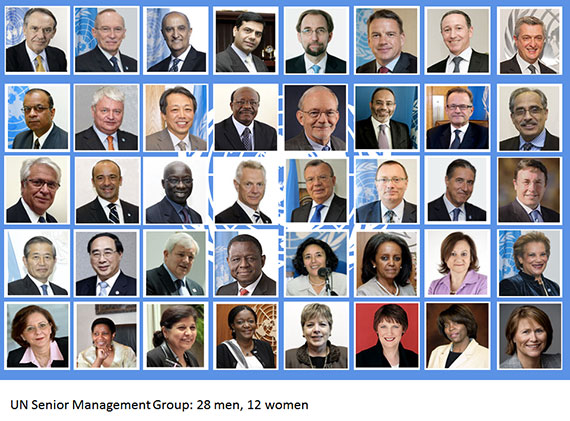
Of 40 faces, we see 28 men, so already not the 50-50 gender parity we would have hoped for. While an intern at the Cyprus Mission at the UN, I heard about this relationship that I discussed previously time and time again, more often than not from these men.
Given this supposed relationship between women and peace and just this example from 2016, I got interested in tracking the representation of women in the UN's senior leadership over time. Now, you all, like myself previously, might expect or might hope that the UN has a clear answer to this question. However, from conversations with the Department of Public Information and Human Resources, even UN women, I found that no one had yet tracked the representation of women in the UN's top levels over decades, not even this decade. Why not?
The UN is a huge global organization, with different departments and agencies and entities and funds.

Unsurprisingly, it follows that its people and its personnel are almost impossible to keep track of. The UN senior leadership is especially difficult to measure, with different agencies and funds and departments having different definitions, different reports, and different ways of counting. In one 2015 report alone, there were four different ways of reporting the gender representation of staff, from 34.4 percent to 41.3 percent to 45.3 percent. And none of these clearly reported on the representation at the senior level, which was the statistic that I wanted.
From meetings with the departments that I mentioned before, what we found was the best, most inclusive, and most consistent way to measure gender balance in the UN senior leadership is—and bear with me here, because the title is long—the secretary-general's report, Composition of the Secretariat: Demographics of Staff. This report has been released annually since 1946. This report contains "a demographic analysis of the global staff of the Secretariat."
In the face of the UN's convoluted data-gathering and reporting practices, I choose to limit my research to the Secretariat. Why? It's important to look at gender equality in the leadership positions of the Secretariat alone because internally its leaders, called the under-secretary-generals and assistant secretary-generals, are considered the leaders of the UN system. What's important to us as perhaps outsiders to the UN is that the Secretariat functions as the executive branch of the UN system. Its leaders make the big decisions.
So if we look here at the Secretariat, it houses all the departments and offices that help the UN manage itself, run itself, and organize itself, from the Executive Office of the Secretary-General to the Department of Management.
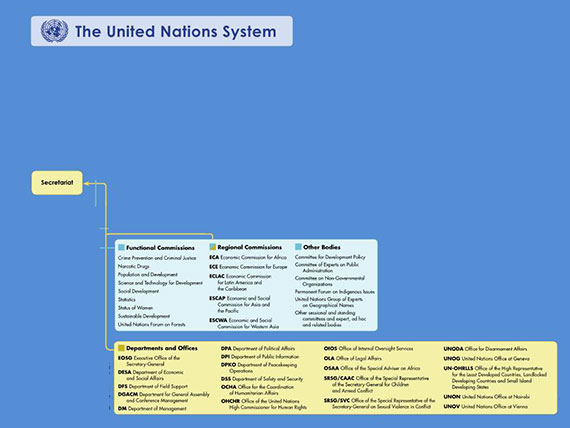
We also see that it houses the biggest branches of the three pillars of UN work: peace and security, with the Department of Peacekeeping Operations and Political Affairs; human rights, with the Office of the High Commissioner for Human Rights; and development, with the Department for Economic and Social Affairs.
I focus on the Secretariat. Here I want to take a step back and just say again what we are looking at. We are looking at the gender representation of the total number of under-secretaries-general and assistant secretaries-general holding this position, regardless of contract type, regardless of source of funding, and regardless of their type of engagement. This is everyone in the Secretariat at this position.
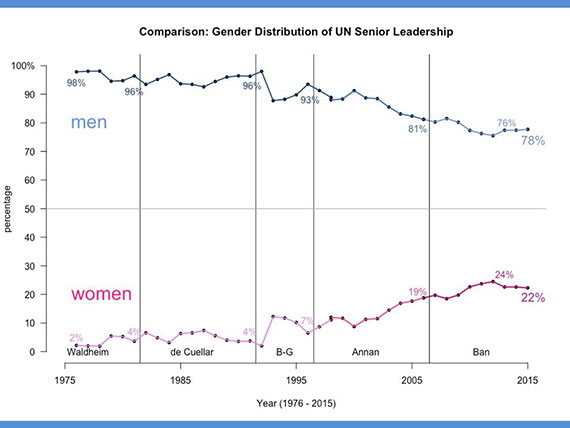
I would also like to point out, while the first gender breakdown in this report is in 1971, I limit my analysis to 1976. So, unlike me, you can just go online and check out my data and make sure that it makes sense, whereas I spent days and days in the UN library doing this from hard archives.
What we are looking at specifically is the proportion of women in these total leadership positions.
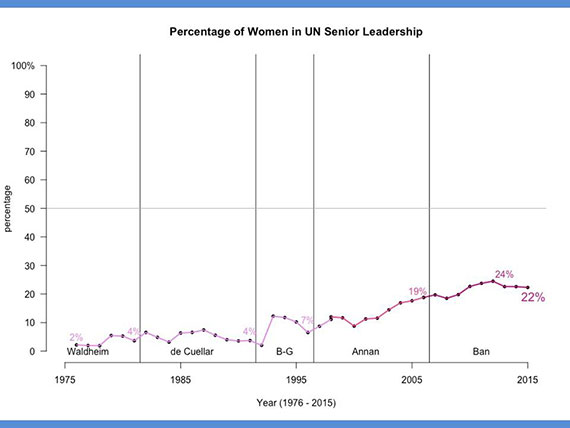
What we see right away is, despite the UN's repeated commitments to 50-50 gender parity, a slow rate of increase over time. Nowhere in time are we close to the 50-50 mark.
But perhaps we don't really expect that any of the past secretaries-general were real champions of women's rights. We have, however, heard some optimistic rhetoric over and over again from the current secretary-general about championing the women's cause and increasing representation of women in the UN, especially at senior levels. This past February, Secretary-General Ban Ki-moon claimed to have appointed 50 or 60 women at the UN's most senior level, all "assistant secretaries-general and under-secretaries-general," and thereby claimed to have singlehandedly "changed the whole landscape for women." Not even a month later, on International Women's Day, he claimed to have "signed nearly 150 letters of appointment to women in these very positions."
So what I want to do now is really zoom in on the last decade and look at the proportion of female leaders under his secretary-generalship. Looking at the raw numbers, perhaps Secretary-General Ban really has done the most for women, but nowhere near what he has claimed in the quotes cited.
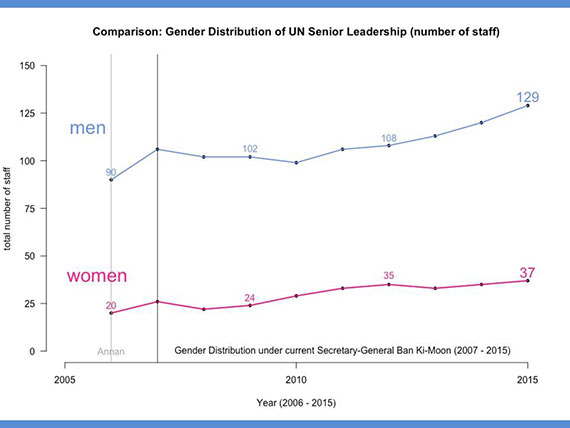
At 37 women in 2015, that is more than any other secretary-general ever put in these positions. Another way to look at this is the rate of change over time. While there is a starting point at 90 men in 2016 compared to 20 women, on average Ban Ki-moon adds to this an average of 5 men per year and about 2 women per year. We see the effect of this. We are seeing the lines begin to diverge on the graph.
We also see this impact in the proportion.
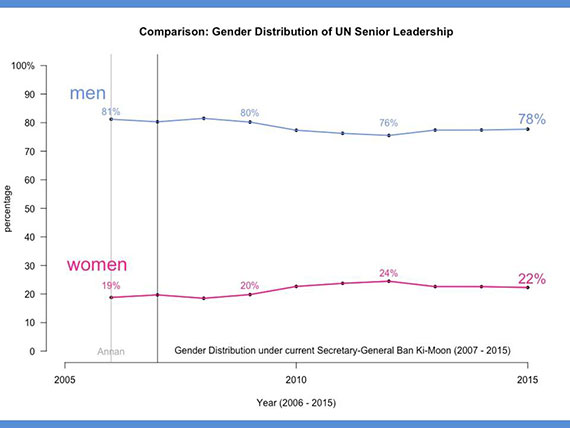
It's important to point out that if we continue this way, the UN will always favor men, unless something significant is done about it. In 2015 we see that the proportion of women is only 22 percent.
So no, Ban Ki-moon has not changed the whole landscape. In fact, at the current rate of increase over his secretary-generalship, from 20 percent in 2007 to 22 percent in 2015, it will take over another century for the UN to reach gender parity.
So how is he getting away with this rhetoric? The numbers just don't seem to match up with the reality. When Ban says appointments, he doesn't mean occupied posts. When people say occupied posts, they don't account for the entire picture. If you look at page 3 of your handout, I show a different way of counting that you can look at on your own time. Basically there is a disturbing and profound lack of clarity in recording and reporting gender balance at the UN senior levels, which exacerbates feelings of distrust that efforts to reach the much-prioritized 50-50 gender parity are actually being made.
At Carnegie Council we are all about peace. Inequality between men and women is a vast injustice. But as I said in my introduction, the underrepresentation of women in decision-making has also proven to greatly undermine peace and counterterrorism efforts. We see the UN come out time and time again for a need for gender parity, not only within its organization, but at the state level. However, we see that the rhetoric used and the reporting used by the institution to describe such efforts towards this do not match the reality.
Aside from the possible relationship between women and effectiveness in peace and development, aside from bringing attention to the gender issues, I'm here to point out that the statistics used by the UN are, frankly, bad and inconsistent. This affects civil society's relationship with the UN and the credibility of UN work.
In addition to the horrible abuses by UN peacekeepers in Central Africa and the cholera outbreak in Haiti, the UN is also failing us in its ability to hold itself accountable to the standards it sets. In fact, it is even disguising the reality. This is a basic problem of accountability and transparency. Rather than owning up to its own mistakes, we see the UN fudge figures and get creative with language and rhetoric and even reporting. It's in everyone's interest that the UN function and it's in everyone's interest that the UN function well.
On one last, perhaps more positive note, it's important for the UN to make good on its priorities because the organization functions as the international bearer of standards. I believe that it is time that the UN reaches this gender balance in its upper echelons, and for the first time perhaps, we have both precedent and hope to do so. The current prime minister of Canada, Justin Trudeau, achieved this 50-50 gender split in his own cabinet as one of his first acts in office. In the UN, in the current next-secretary-general selection process, nominees, which now include women, are feeling more pressure than ever before to do just that. There are nominees promising a 50-50 Secretariat and a 50-50 representation among senior staff from day one.
But these are still words. It is past due for the UN to make good on its promises.
QuestionsQUESTION: Thank you so much. I love this kind of research. You are looking at data and you are saying, "Wait, this doesn't make sense." You're challenging the statements and you're saying, "Wait a second, I'm going to actually go and find the right numbers." It's great.
As you finished, I'm hopeful that the next secretary-general will get things better, because it has been abhorrent in terms of all the issues that you address, but the fact that they really come up short on this, which is such a significant claim, when they talk so much about gender equality and they are not doing it at the highest levels of the United Nations.
I really hope that you will maybe think about writing an op-ed, because I think that would be great, especially in advance of the fall.
OURANIA YANCOPOULOS: I would love to. Just on that, it should be noted that this information was published in openDemocracy for International Women's Day and a pitch was made to The New York Times. They took the pitch, but I, alas, did not write an op-ed. I wrote, rather, very similar to what you see on openDemocracy. So if you have ideas about crafting this more at an op-ed angle, I would love to discuss that further.
QUESTION: I second many of those feelings. I was just curious. The rhetoric that Ban Ki-moon is championing, what, it turns out, is really soft language and fudged statistics maybe—I don't know if you looked back at rhetoric from other secretaries-general. Do we see, in addition to sort of general pushes for gender equality that come out of the UN—was there rhetoric in the past about staffing at the Secretariat that was also not lived up to? Is this something that Ban Ki-moon—is that new, that we are even seeing him trying to take credit for it, even if it's not something that he can really take credit for?
OURANIA YANCOPOULOS: I think that's really interesting. I didn't look back and look at the rhetoric of past secretaries-general. But in doing my research, what I found was that there is this huge emphasis on equitable geographic representation. From the very beginning, it was always about, in the staffing of the Secretariat, is each region, is each country represented equitably.
Because I was an intern at the Cyprus Mission, a colleague and I at the Cyprus Mission decided to just look at Cyprus. What we saw, just in 2015, was that while it was put at—there are different levels of representation. It's either underrepresentation, represented, or overrepresented. There are seven different categories—I believe seven—that they gauge this overall label of "represented" on. While Cyprus was labeled as represented, it was underrepresented in the majority of these categories. If I remember correctly, it was underrepresented in four out of the seven categories. So is it really fair to say that it is overall represented when it is not? I don't know.
It would be interesting to take that angle and look at geographic representation and match that up, the reality of the rhetoric, but also see what past secretaries-general have done.
Just one point on the female representation and past rhetoric. Kofi Annan was somebody who spoke more through his actions than his words. It's important to note—and I don't have a plot with the raw numbers for this presentation—while Ban Ki-moon added another 17 women than Kofi Annan had and raised it from 20 to 37, Kofi Annan had done the same. While under Boutros-Ghali there were only 13 women in these positions, Kofi Annan raised it to 20. At least in the preliminary research that I did, he never said, "Oh, I'm championing women's rights," but in terms of actual numbers, he added and did just the same as Ban Ki-moon.
DEVIN STEWART: Let's thank everyone for the extraordinary presentations today. Thank you so much.


